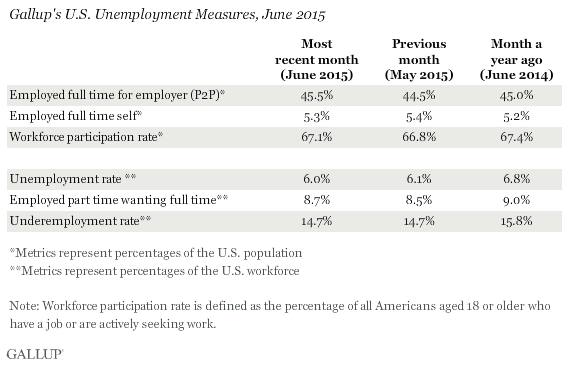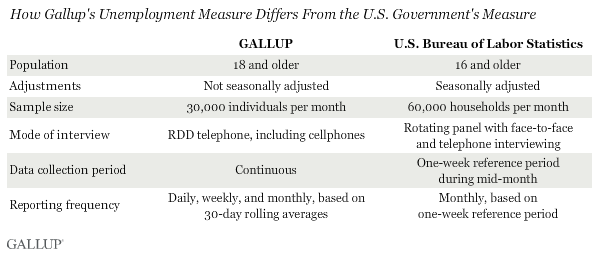U.S. Payroll to Population Rate Rises to 45.5% in June
Monday, July 13th, 2015
The U.S. Payroll to Population employment rate (P2P), as measured by Gallup, was 45.5% in June. This is up one full percentage point from the previous month, and 0.5 points higher than the rate measured in June 2014. This development represents the strongest month-to-month change for P2P since May 2014, and continues the rise seen last month.
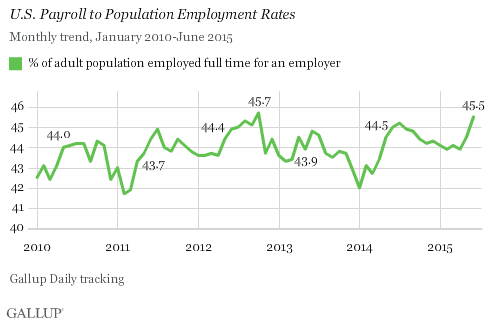
P2P is now at the highest it has been since October 2012, which in turn was the highest point in Gallup's five-year trend on this measure. This increase in the summer months is in line with an expected seasonal rise in full-time employment.
Gallup's P2P metric tracks the percentage of the U.S. adult population aged 18 and older who are working for an employer for at least 30 hours per week. P2P is not seasonally adjusted. The latest results are based on Gallup Daily tracking interviews with 28,355 Americans, conducted June 1-29 by landline telephone and cellphone. Gallup does not count adults who are self-employed, work fewer than 30 hours per week, are unemployed or are out of the workforce as payroll-employed in the P2P metric.
Overall, P2P is an important measure of the health of the economy; P2P tracks closely with other objective measures of economic productivity such as GDP per capita, as well as with subjective measures such as life evaluations and physical well-being.
Workforce Participation at 67.1% in June
The percentage of U.S. adults participating in the workforce in June was 67.1%. This is up from May, and is the highest rate since September 2014 by 0.1 points. However, it is still 0.3 points lower than the rate measured in June 2014, 67.4%. Since May 2010, the workforce participation rate has remained in a range encompassing a low of 65.8% and a high of 68.5%, although in the past two years it has most often remained below 67.0%. Workforce participation measures the percentage of adults aged 18 and older who are working, or who are not working but are actively looking for work and are available for employment.
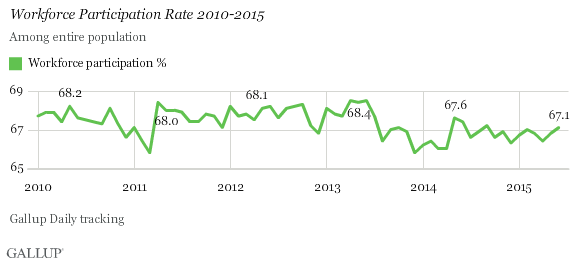
Unemployment Steady at 6.0%
Gallup's unadjusted U.S. unemployment rate is at 6.0% in June, down slightly from May (6.1%), and except for one reading of 5.8% in December 2014, is the lowest in Gallup's five-year trend. Gallup's U.S. unemployment rate represents the percentage of adults in the workforce who did not have any paid work in the past seven days, for an employer or themselves, and who were actively looking for and available to work.

Unlike Gallup's P2P rate, which is a percentage of the total population, the unemployment rates that Gallup and the U.S. Bureau of Labor Statistics report are percentages within the labor force. While both Gallup and BLS data are based on surveys with very large sample sizes, the two have important methodological differences -- outlined at the end of this article. Additionally, the most-discussed unemployment rate released by the BLS each month is seasonally adjusted, while Gallup reports unadjusted numbers. Although Gallup's employment numbers strongly correlate with BLS rates, the BLS and Gallup estimates of unemployment do not always track precisely on a monthly basis.
Underemployment Unchanged at 14.7%
Gallup's measure of underemployment in June is 14.7%, unchanged from May, and both months' readings represent the lowest level recorded since Gallup began tracking it daily in 2010. Gallup's U.S. underemployment rate combines the percentage of adults in the workforce who are unemployed (6.0%) and those who are working part time but desire full-time work (8.7%). The percentage of the workforce in this latter category has varied between 8.4% and 10.1% since January 2010.
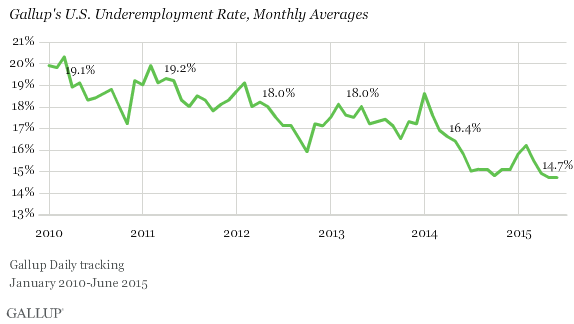
Bottom Line
Full-time employment for an employer continues to increase through the first month of summer, after a slow start in 2015. It is now at its highest measurement since 2012. Underemployment remained at the lowest rate Gallup has measured in the five-year history of the trend, after reaching this level in May. One component of that measure -- unemployment -- is now as low as Gallup has measured it with the exception of one lower reading in December 2014. Additionally, in May 2015, Gallup's Job Creation Index reached the highest point since its inception in January 2008.
Despite these positive signs for the strength of the U.S. labor market, Americans' enthusiasm about the economy as measured by Gallup's Economic Confidence Index has been trending down, not up, in recent months, although confidence is higher than it was in the years following the financial meltdown in 2008.
The data in this article are available in Gallup Analytics.
